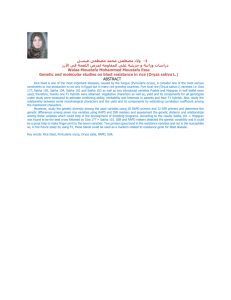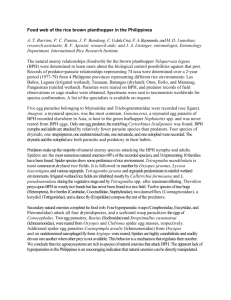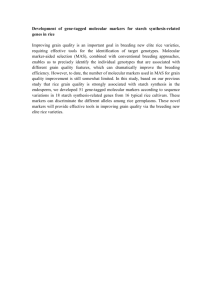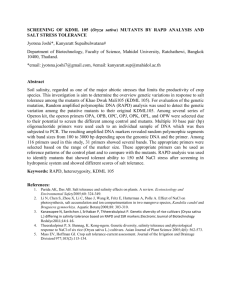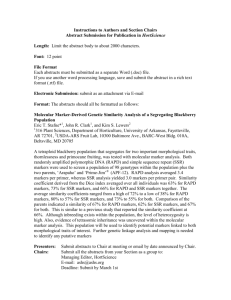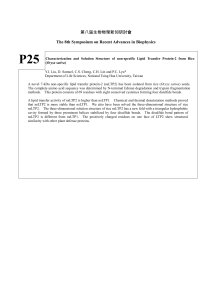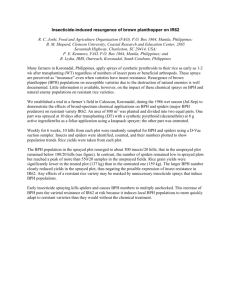Identification of coupling- and repulsion
advertisement
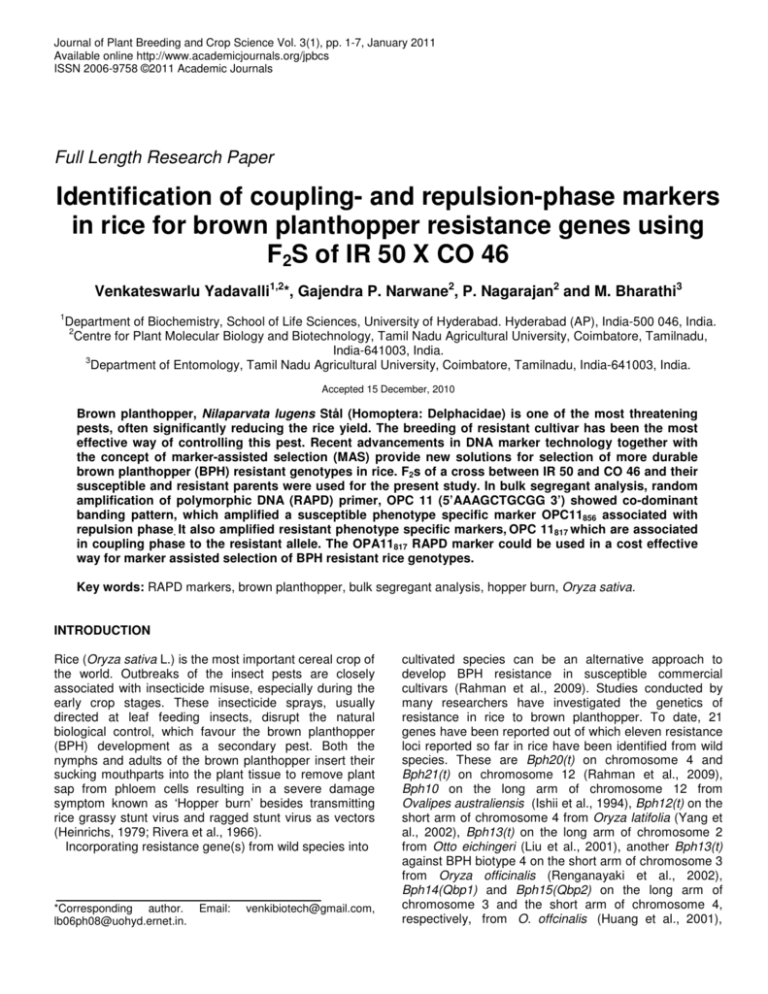
Journal of Plant Breeding and Crop Science Vol. 3(1), pp. 1-7, January 2011 Available online http://www.academicjournals.org/jpbcs ISSN 2006-9758 ©2011 Academic Journals Full Length Research Paper Identification of coupling- and repulsion-phase markers in rice for brown planthopper resistance genes using F2S of IR 50 X CO 46 Venkateswarlu Yadavalli1,2*, Gajendra P. Narwane2, P. Nagarajan2 and M. Bharathi3 1 Department of Biochemistry, School of Life Sciences, University of Hyderabad. Hyderabad (AP), India-500 046, India. 2 Centre for Plant Molecular Biology and Biotechnology, Tamil Nadu Agricultural University, Coimbatore, Tamilnadu, India-641003, India. 3 Department of Entomology, Tamil Nadu Agricultural University, Coimbatore, Tamilnadu, India-641003, India. Accepted 15 December, 2010 Brown planthopper, Nilaparvata lugens Stål (Homoptera: Delphacidae) is one of the most threatening pests, often significantly reducing the rice yield. The breeding of resistant cultivar has been the most effective way of controlling this pest. Recent advancements in DNA marker technology together with the concept of marker-assisted selection (MAS) provide new solutions for selection of more durable brown planthopper (BPH) resistant genotypes in rice. F2s of a cross between IR 50 and CO 46 and their susceptible and resistant parents were used for the present study. In bulk segregant analysis, random amplification of polymorphic DNA (RAPD) primer, OPC 11 (5’AAAGCTGCGG 3’) showed co-dominant banding pattern, which amplified a susceptible phenotype specific marker OPC11856 associated with repulsion phase. It also amplified resistant phenotype specific markers, OPC 11817 which are associated in coupling phase to the resistant allele. The OPA11817 RAPD marker could be used in a cost effective way for marker assisted selection of BPH resistant rice genotypes. Key words: RAPD markers, brown planthopper, bulk segregant analysis, hopper burn, Oryza sativa. INTRODUCTION Rice (Oryza sativa L.) is the most important cereal crop of the world. Outbreaks of the insect pests are closely associated with insecticide misuse, especially during the early crop stages. These insecticide sprays, usually directed at leaf feeding insects, disrupt the natural biological control, which favour the brown planthopper (BPH) development as a secondary pest. Both the nymphs and adults of the brown planthopper insert their sucking mouthparts into the plant tissue to remove plant sap from phloem cells resulting in a severe damage symptom known as ‘Hopper burn’ besides transmitting rice grassy stunt virus and ragged stunt virus as vectors (Heinrichs, 1979; Rivera et al., 1966). Incorporating resistance gene(s) from wild species into *Corresponding author. lb06ph08@uohyd.ernet.in. Email: venkibiotech@gmail.com, cultivated species can be an alternative approach to develop BPH resistance in susceptible commercial cultivars (Rahman et al., 2009). Studies conducted by many researchers have investigated the genetics of resistance in rice to brown planthopper. To date, 21 genes have been reported out of which eleven resistance loci reported so far in rice have been identified from wild species. These are Bph20(t) on chromosome 4 and Bph21(t) on chromosome 12 (Rahman et al., 2009), Bph10 on the long arm of chromosome 12 from Ovalipes australiensis (Ishii et al., 1994), Bph12(t) on the short arm of chromosome 4 from Oryza latifolia (Yang et al., 2002), Bph13(t) on the long arm of chromosome 2 from Otto eichingeri (Liu et al., 2001), another Bph13(t) against BPH biotype 4 on the short arm of chromosome 3 from Oryza officinalis (Renganayaki et al., 2002), Bph14(Qbp1) and Bph15(Qbp2) on the long arm of chromosome 3 and the short arm of chromosome 4, respectively, from O. offcinalis (Huang et al., 2001), 2 J. Plant Breed. Crop Sci. Bph18(t) on the long arm of chromosome 12 from O. australiensis (Jena et al., 2006), and bph11(t) and bph12(t) on the long arm of chromosome 3 and chromosome 4 respectively, from O. officinalis (Hirabayashi et al., 1999). Dominant gene, Bph1, governing resistance in ‘Mudgo’, ‘MTU15’, ‘Co22’, and ‘MGL2’ (Athwal et al., 1971), where as a single recessive gene, bph2, conveys resistance in ‘ASD7’ and ‘Ptb18’. Sri Lankan cultivar Rathu Heenati has a dominant gene for resistance, which is non-allelic to, and independent of, Bph1 and was designated as Bph3 (Lakshminarayana and Khush, 1977). Another Sri Lankan cultivar, Babawee, has a recessive gene for resistance (Lakshminarayana and Khush, 1977), this gene is independent of bph2 and is designated as bph4. Later bph5 in ‘ARC10550’, Bph6 in ‘Swarnalatha’ and bph7 in ‘T12’, by means of BPH biotypes from Bangladesh (Kabir and Khush, 1988; Bharathi and Chelliah, 1991). Another recessive gene, bph8, identified in ‘Thai Col.5’, ‘Thai Col 11’ and ‘Chin Saba’. In the Sri Lankan local cultivars, Pokkali, Balamawee, and Kaharamana a dominant gene, Bph9, identified by Nemato et al. (1989). Populations of BPH were categorized into five biotypes on the basis of their differential reactions to a set of reference cultivars (Chelliah and Bharathi, 1993). In most of the map construction, F2 segregating populations are the result of selfing F1s of two homozygous inbred lines. Most of the molecular maps to date are based on segregation data from F2 progenies (Jena and Khush, 1992; Wu et al., 2002). A novel BPH resistance gene has been introduced into cultivated rice lines from a distantly related species of Oryza and the gene has been mapped with a DNA marker by RAPD and bulked segregant analysis method (Jena and Khush, 1992; Jeon et al., 1999). Bulk segregant analysis (BSA) is a rapid procedure for identifying markers in specific regions of the genome, in which two pools contrasting for a trait are analyzed to identify markers that distinguish them (Michelmore et al., 1991). Two types of molecular markers have been used to develop detailed genetic maps in, RFLPs and RAPDs in rice (Huang et al., 1997; McCouch et al., 1997; Jeon et al., 1999). PCR based RAPD markers have been used for tagging agronomic traits in several crops (Martin et al., 1991; Nair et al., 1995; Ford et al., 1999; Manninen, 2000). RFLPs are often co-dominant but are restricted to regions with low or single copy sequences, moreover it requires large amount of highly pure DNA, specific probes and time consuming. RAPD relies on the differential enzyme amplification of small DNA fragments using PCR with arbitrary oligonucleotide primers (usually 10 mers). Polymorphisms result from either chromosomal changes in the amplified regions or base changes that alter primer binding. The procedure is rapid, requires only small quantity of DNA, which need not be of high quality, and involves no radioactivity. As no southern hybridization is involved, polymorphisms can be detected in fragments containing highly repeated sequences; this provides markers in regions of the genome previously inaccessible to analysis. Due to its simplicity, inexpensiveness still using for marker assisted selection in Pisum sativum for nematode resistance (Burrow et al., 1996; Garcia et al., 1996), scab resistance in Malus domestica (Yang et al., 1997), sclerotinia rot resistance in Trifolium pratense (Page et al., 1997), brown planthopper resistance in F3 population of interspecific cross between O. sativa and O. officinalis (Jena et al., 2002), anthracnose resistance and angular leaf spot resistance in Phaseolus vulgaris (Caixeta et al., 2003; Martin and Menarim, 2000), soybean mosaic virus resistance in Glycine max (Zheng et al., 2003), rust resistance in Vicia faba (Avila et al., 2003), rust resistance in P. sativum (Vijayalakshmi et al., 2005), Fusarium wilt resistance in Cajanus cajan (Kotresh et al., 2006), karnal bunt resistance in Triticum aestivum (Kumar et al., 2006), anthracnose resistance gene in sorghum (Singh et al., 2006), Arachis hypogaea for rust resistance (Mondal et al., 2007; He and Prakash, 1997). Bph 1 has been tagged in rice by using bulked segregant analyses, with 520 RAPD primers to identify markers linked to the BPH resistance gene (Kim and Sohn, 2005). In the present study 170 RAPD primers were used for tagging of bph resistance genes in the F2s of IR 50 x CO 46. MATERIALS AND METHODS Screening for BPH resistance Screening for BPH resistance was done in the green house, paddy breeding station (PBS), coimbatore by ‘standard seed box screening’ test (Heinrichs and Mochida, 1984). The F2s of the cross IR 50 X CO 46 were tested along with the susceptible check (TN1) and the resistant check (CO 46) for their resistance to BPH infestation. Seven days after sowing, when the seedlings were at three-leaf stage they were infected with second and third instar nymphs (8 nymphs of BPH per seedling). When the seedlings of the susceptible check were almost completely dead, the test entries were rated according to the damage rating of the standard evaluation system for rice (International Rice Research Institute, 1996) (Table 1). Isolation of genomic DNA Isolation of genomic DNA was done following the method recommended by Jena et al. (2002) with slight modifications. To extract DNA from the parents, the F2s from the scored plants, the surviving plants immediately after screening were freed from the insects and were planted in separate clay pots in order to grow those to grown up stage for about 15 to 20 days so as to extract sufficient quantity of DNA. RAPD and bulk segregant analysis The RAPD analysis was performed following the method recommended by Saiki et al. (1988) with required modifications. A total of seventy-three decamer primers obtained from Operon Technologies Inc., California, USA were used in this study. 10 ng of template DNA was used for PCR amplification, which is carried out Yadavalli et al. 3 Figure 1. Artificial screening for BPH resistance in the F2s. Each lane consists of 17 seedlings. First 10 lanes from left to right constitutes a total of 170 seedlings of the cross IR 50 x CO 46. 11th lane is the susceptible check (IR 50) and 12th lane is Resistant check (CO 46). in a total volume of 20 µL. The final concentrations are 100 pmol primers, 0.5 mM each of dGTP, dATP, dTTP, dCTP, one unit of Taq polymerase (Invitrogen) and 1X PCR buffer containing 1.5 mM MgCl2. The programme for amplification was setup for initial denaturation at 95°C for 3 min, and then thirty amplification cycles each amplification cycle contained one denaturation step at 94°C for one minute, annealing step at 36°C for 40 s and one extension step at 72°C. Final extension was set for three min at 72°C in a thermal cycler (Eppendorf, USA). PCR amplification products were run on 1.2% agarose gels containing 0.2 µg/mL ethidium bromide in a standard horizontal gel electrophoresis unit (Broviga, Chennai, India) having TBE buffer (90 mM Tris-borate, 1 mM EDTA pH 8.0). The DNA bands were photographed in a gel documentation system. Initially IR 50 (Susceptible) and Co 46 (resistant) parents were screened with all 73 decamer primers. Polymorphic primers were tested on two DNA bulks, as well as parents (Michelmore et al., 1991). Those primers, which show polymorphism between the parents were used to test for polymorphism in the F2 population of resistant and susceptible populations each comprising ten samples. Resistant bulk comprises of the genomic DNA from all ten resistant populations in the same way susceptible bulk comprises of genomic DNA from all 10 susceptible populations which are used in this study. EXPERIMENTAL RESULTS Inheritance pattern of BPH resistance gene in the F2 progeny A total of 170 F2s were categorized as resistant and susceptible. The plants showing a damage score of 3 and 5 were grouped as resistant (124) and plants showing a damage score of 7 and 9 were grouped as susceptible 2 (46). This data fitting well to the expected 3:1 ratio ( = 0.38, P 0.50 to 0.75) (Figures 1, 2 and Table 1). Identification resistance of RAPD marker linked to BPH Out of the total 73 RAPD primers initially screened on the parental lines of IR 50 and CO 46, 18 primers (24.6%) showed amplification in both parents. Among these 18 primers, 7 primers did not show any polymorphism and the remaining 11 primers showed reproducible polymorphism between parents. Among these 11 primers, 4 primers showed co-dominant banding pattern of polymorphism between parents. This could be useful for distinguishing heterozygotes from homozygotes. Three primers produced dominant amplicons specific to resistant parent and four primers shown susceptible parent specific amplicons (Table 2). Out of four codominant RAPD primers, one primer that is, OPC 11 shown distinct, repeatable and high degree of polymorphism in the resistant parent, resistant bulk, susceptible parent and susceptible bulks. OPC 11 generated polymorphic DNA fragments of OPC 11817 (817 bp) and OPC 11856 (856 bp). Out of these two markers identified, OPC 11817 was associated in coupling J. Plant Breed. Crop Sci. Number of seedlings 4 Figure 2. Hopper burn severity score of 170 F2 seedlings of the cross IR 50 x CO 46 based on standard evaluation system. Table 1. Standard evaluation system for rice brown planthopper damage. Scale 0 1 3 5 7 9 Criteria None Very slight damage First and second leaves with orange tips; slight stunting More than half the leaves with yellow - orange tips; pronounced stunting More than half of the plants wilting or dead and remaining plants severely stunted or drying All plants dead Category Highly resistant Resistant Moderately resistant Moderately susceptible Susceptible. Table 2. Pattern of polymorphism between parents (IR 50 and CO 46) detected by RAPD analysis using Operon primers. Polymorphic type Co-dominant Dominant (Resistant specific band) Recessive (Susceptible specific band) Monomophic No amplification Total phase to the resistant allele, while OPC 11856 was linked in repulsion phase (Figure 3). DISCUSSION The performance of the parents IR 50, CO 46 and the F2s Primers (No) 4 3 4 7 55 73 Polymorphism (%) 5.4 3.8 5.19 9.09 71.42 100 during screening reveals the consistency of the screening protocols for BPH resistance in this study. DNA amplified products obtained from PCR analysis using random primers have been proposed as an alternative method in targeting DNA sequences for genetic characterization and mapping (Williams et al., 1990). Relatively higher number of amplified products per Yadavalli et al. 5 Figure 3. Co-segregation banding pattern of the RAPD primer OPC 11. OPC 11817 was associated in coupling phase to the resistant allele, while OPC 11856 was linked in repulsion phase. primer were found in rice, when compared to other plants, like maize (Welsh and McClelland, 1990). One of the most time consuming requirements of DNA marker development, is the need to screen entire mapping populations, with every probe or primer and this has been removed by the bulk segregant analysis (BSA). The minimum size of the bulk is determined by the frequency with which linked loci might be detected as polymorphic between the bulked samples. For a dominant RAPD marker, the probability of a bulk of ‘n’ individuals having band and a second bulk of equal number of individuals not having a n n band will be 2(1-1/4) (1/4) , when a locus is linked to the target gene (Michlemore et al., 1991). Of the four primers (OPC 10, OPC 11, OPE 14 and OPM 13) that were tested in the BSA with the resistant and susceptible bulks along with the resistant parent and susceptible parent and their F2s, only one primer, that is, OPC 11 showed co dominant phenotype specific banding pattern. Two pools contrasting for a trait, that is, resistant and susceptible to BPH were analyzed to identify markers that distinguish them. Markers that are polymorphic between the bulks were genetically linked to the loci that determine the trait was used to construct the pools (Michelmore et al., 1991). Results obtained in F2 seedlings indicate that RAPDs are co-dominant, highly polymorphic and informative in nature. These co-dominant RAPD markers are comparatively rare. Similar to other kinds of co-dominant markers, these co-dominant RAPDs can be of particular value for the purpose of linkage analysis because they provide maximum linkage information per individual in the segregating populations. Co-dominant markers provides easy discrimination between recombinant homozygotes to recombinant heterozygote’s (Williams et al., 1990; Mohan et al., 1997; Semagn et al., 2006). RAPD markers which show co-dominant nature were successfully employed in marker assisted selection (MAS) in various crops (Jena et al., 2002; Mondal et al., 2007). Phenotypic evaluation should be performed with more reliable methods to avoid false positives in further MAS (Mackill and Ni, 2001). A clear polymorphism between the bulks comparable to that between the parents was observed. Poulson et al. (1995) suggested that when bulks are constructed from enough individuals, the BSA is sufficiently robust to cope with the low level of phenotypic misclassification. Bulk segregant analysis by using RAPD markers were successfully used in the development of linked molecular markers. Thus, OPA11817 RAPD marker could be used in a cost effective way for marker assisted selection of BPH resistant rice genotypes ACKNOWLEDGEMENTS The authors sincerely acknowledge DBT and the Government of India, for providing financial assistance to the study. Also, they acknowledge Mr. K. Kalyana Babu, Scientist, VKPAS, Almora (UK), India and Mr. M.S.R Krishna for their critical suggestions on the preparation of the manuscript. 6 J. Plant Breed. Crop Sci. REFERENCES Athwal DS, Pathak MD, Bacalangco EH, Pura CD (1971). Genetics of resistance to brown planthopper and green leafhopper in Oryza sativa L. Crop. Sci., 1: 747-750. Avila CM, Sillero JC, Rubiales D, Moreno MT, Torres AM (2003). Identification of rapd markers linked to the uvf-1 gene conferring hypersensitive resistance against rust (Uromyces viciae-fabae) in vicia faba l. Theor. Appl. Genet., 107(2): 353-358. Bharathi M, Chelliah S (1991). Genetics of rice resistance to brown planthopper and relative contribution of genes to resistance mechanisms. Rice genetics ii, IRRI, Rice genet. II, pp 255-261. Burrow MD, Simpson CE, Paterson AH, Starr JL (1996). Identification of peanut (Arachis hypogaea L.) RAPD markers diagnostic of root-knot nematode (Meloidigyne arenaria (neal) chitwood) resistance. Mol. Breed., 2: 368-379. Caixeta ET, Bor´em A, Fagundes SA, Niestche S, Barros EG, Moreira MA (2003). Inheritance of angular leaf spot resistance in common bean line bat 332 and identification of RAPD markers linked to the resistance gene. Euphytica, 134: 297-303. Chelliah S, Bharathi M (1993). Biotypes of the brown planthopper, Nilaparvata lugens (homoptera: Delphacidae)—host inxuenced biology and behavior. Chemical ecology of phytopathogous insects. International Science Publishers New York, pp 133-148. Ford R, Pang ECK, Taylor PWJ (1999). Genetics of resistance to ascochyta blight (Ascochyta lentis) of lentil and the identification of closely linked rapd markers. Theor. Appl. Genet., 98: 93-98. Garcia GM, Stalker HT, Shroeder E, Kochert GA (1996). Identification of RAPD, SCAR and RFLP markers tightly linked to nematode resistance genes introgressed from Arachis cardenasii to A.hypogaea. Genome, 39: 836-845. He G, Prakash CS (1997). Identification of polymorphic DNA markers in cultivated peanut (Arachis hypogaea L.). Euphytica. 97:143–149. Heinrichs EA (1979). Control of leafhopper and planthopper vectors of rice viruses. In: Moramorosch K, arris KF (eds) leafhopper vectors and planthopper disease agents. Academic Press, New York. Heinrichs EA, Mochida O (1984). From secondary to major pest status: The case of insectcticide-induced rice brown planthopper, Nilaparvata lugens resurgence. Protection Ecol., 7:201-218. Hirabayashi H, Kaji R, Angeles ER, Ogawa T, Brar DS, Khush GS (1999). RFLP analysis of a new gene for resistance to brown planthopper derived from O. officinalis on rice chromosome 4. Breed. Sci., 48: 48. Huang N, Arnold P, Mew T, Magpantay G, McCouch S, Guiderdoni E, Xu J, Subudhi P, Angeles R, Khush GS (1997). RFLP mapping of isozymes, RAPD and QTLs for grain shape, brown planthopper resistance in a doubled haploid rice population. Mol. Breed., 1: 1-8. Huang Z, He G, Shu L, Li X, Zhang Q (2001). Identification and mapping of two brown planthopper resistance genes in rice. Theor. Appl. Genet., 102: 929-934. International Rice Research Institute (ed) (1996). Standard evaluation system for rice, 4th edn. International Rice Research Institute, Manila, Philippines. Ishii T, Brar DS, Multani DS, Khush GS (1994). Molecular tagging of genes for brown planthopper resistance and earliness introgressed from oryza australiensis into cultivated rice, O. Sativa. Genome, 37 (2): 217-221. Jena KK, Jeung JU, Lee JH, Choi HC, Brar DS (2006). High-resolution mapping of a new brown planthopper (bph) resistance gene, bph18(t), and marker-assisted selection for BPH resistance in rice (Oryza sativa L.). Theor. Appl. Genet., 288: 288-297. Jena KK, Khush GS (1992). Introgression of genes from Oryza officinalis well ex watt to cultivated rice, O. Sativa L. Theor. Appl. Genet., 80: 737-745. Jena KK, Pasalu IC, Rao YK, Varalaxmi Y, Krishnaiah K, Khush GS, Kochert G (2002). Molecular tagging of a gene for resistance to brown planthopper in rice (Oryza sativa L.). Euphytica. 129:81–88. Jeon YH, Ahn SN, Choi HC, Hahn TR, Moon HP (1999). A RAPD marker for the gene conferring resistance to indian biotype of bph. Rice Genet. Newsl., 15: 133-134. Kabir MA, Khush GS (1988). Genetic analysis of resistance to brown planthopper in rice, (Oryza sativa L.). Plant Breed., 100: 54-58. Kim SM, Sohn JK (2005). Identification of a rice gene (bph 1) conferring resistance to brown planthopper (Nilaparvata lugens Stål) using STS markers. Mol. Cells, 20(1): 30-34. Kotresh H, Fakrudin B, Punnuri SM, Rajkumar BK, Thudi M, Paramesh H, Lohithaswa H, Kuruvinashetti MS (2006). Identification of two RAPD markers genetically linked to a recessive allele of a fusarium wilt resistance gene in pigeonpea (Cajanus cajan L. Mill sp.). Euphytica, 149: 113-120. Kumar M, Luthra OP, Chawla V, Chaudhary L, Saini N, Poonia A, Kumar R, Singh AP (2006). Identification of rapd markers linked to the karnal bunt resistance genes in wheat. Biol. Plant. 50(4): 755758. Lakshminarayana A, Khush GS (1977). New genes for resistance to brown planthopper in rice. Crop Sci., 17: 96-100. Liu GQ, Yan H, Fu Q, Qian Q, Zhang ZT, Zhai WX, Zhu LH (2001). Mappping of a new gene for brown planthopper resistance in cultivated rice introgressed from Oryza eichingeri. Chin. Sci. Bull., 46: 738-742. Mackill DJ, Ni J (2001). Molecular mapping and marker assisted selection for major gene traits in rice. Rice genetics iv. Science Publishers, Inc., IRRI, Philippines, pp 137-151. Manninen OM (2000). Associations between anther-culture response and molecular markers on chromosomes 2h, 3h and 4h of barley (Hordeum vulgare L.). Theor. Appl. Genet., 100:57-62. Martin ALA, Menarim H (2000). Identification of RAPD marker linked to the co-6 anthracnose resistant gene in common bean cultivar ab 136. Genet. Mol. Biol., 23 (3): 633-637. Martin GB, Williams JGK, Tanksley SD (1991). Rapid identification of markers linked to a pseudomonas resistance gene in tomato by using random primers and near isogenic lines. Proc. Natl. Acad. Sci. USA, 88: 2336-2340. McCouch SR, Chen X, Panaud O, Temnykh S, Xu Y, Cho YG, Huang N, Ishii T, Blair M (1997). Microsatellite marker development, mapping and applications in rice genetics and breeding. Plant. Mol. Biol., 35: 89-99. Michelmore R, Paran WI, Kesseli RV (1991). Identification of markers linked to disease resistance genes by bulked-segregant analysis : A rapid method to detect markers in specific genome regions by using segregating populations. Proc. Natl. Acad. Sci. USA, 88: 9828-9832. Mohan M, Nair S, Baghwat A, Krishna TG, Yano M, Bhatia CR, Sasaki T (1997). Genome mapping, molecular markers and marker-assisted selection in crop plants. Mol. Breed., 3: 87-103. Mondal S, Badigannavar AM, Murty GSS (2007). RAPD markers linked to a rust resistance gene in cultivated groundnut (Arachis hypogaea L.). Euphytica, 159: 233-239. Nair S, Bentur JS, PrasadaRao U, Mohan M (1995). DNA markers tightly linked to a gall midge resistance gene (gm2) are potentially useful for marker-aided selection in rice breeding. Theor. Appl. Genet., 91: 68-73. Nemato HR, Ikeda, Kaneda C (1989). New genes for resistance to brown planthopper, in rice. Japan J. Breed., 39: 23-28. Page D, Delclos B, Aubert G, Bonavent JF, Mousset-Declas C (1997) Sclerotinia rot resistance in red clover: Identification of rapd markers using bulked segregant analysis. Plant Breed., 116: 73-78. Poulson DME, Henry RJ, Johnston RP, Irwin JAG, Rees RG (1995). The use of bulk segregant analysis to identify a RAPD marker linked to leaf rust resistance in barley. Theor. Appl. Genet., 91: 270-273. Rahman ML, Jiang W, Chu SH, Qiao Y, Ham TH, Woo MO, Lee J, Khanam MS, Chin JH, Jeung JU, Brar DS, Jena KK, Koh HJ (2009). High-resolution mapping of two rice brown planthopper resistance genes, bph20(t) and bph21(t), originating from Oryza minuta. Theor. Appl. Genet., 119: 1237-1246. Renganayaki K, Fritz AK, Sadasivam S, Pammi S, Harrington SE, McCouch SR, Kumar SM, Sam RA (2002). Mapping and progress toward map-based cloning of brown planthopper biotype-4 resistance gene introgressed from Oryza officinalis into cultivated rice, O. sativa. Crop Sci., 42: 2112-2117. Rivera CT, Ou SH, Lida TT (1966). Grassy stunt disease of rice and its transmission by Nilaparvata lugens (Stål). Plant Dis. Rep., 50: 453456. Saiki RK, Gelfand DH, Stoffel S, Scarf SJ, Higuchi R, Horn GT, Mullis KB, Erlich HA (1988). Primer directed enzymatic amplification of DNA Yadavalli et al. with a thermostable DNA polymerase. Science, 239: 487-491. Semagn K, Bjørnstad A, Ndjiondjop MN (2006). Principles, requirements and prospects of genetic mapping in plants. Afr. J. Biotech., 5(25): 2569-2587. Singh M, Chaudhary K, Singal HR, Magill CW, Boora KS (2006). Identification and characterization of RAPD and SCAR markers linked to anthracnose resistance gene in sorghum [sorghum bicolor (L.) moench]. Euphytica, 149: 179-187. Vijayalakshmi S, Yadav K, Kushwaha C, Sarode SB, Srivastava CP, Chand R, Singh BD (2005). Identification of RAPD markers linked to the rust (Uromyces fabae) resistance gene in pea (Pisum sativum). Euphytica, 144: 265-274. Welsh J, McClelland M (1990). Fingerprinting of genomes using PCR with arbitrary primers. Nucleic Acid Res., 18: 7213-7218. Williams JGK, Kubelik AR, Livak KJ, Rafalski JA, Tingey SV (1990). DNA polymorphisms amplified by arbitrary primers are useful as genetic markers. Nucleic Acids Res., 18: 6531-6535. 7 Wu JY, Wu HK, Chung MC (2002). Co-dominant RAPD markers closely linked with two morphological genes in rice (Oryza sativa L.) Bot. Bull. Acad. Sin., 43: 171-180. Yang H, Ren X, Weng Q, Zhu L, He G (2002). Molecular mapping and genetic analysis of a rice brown planthopper (Nilaparvata lugens Stål) resistance gene. Hereditas, 136(1): 39-43. Yang HY, Korban SS, Kruger J, Schmidt H (1997). The use of a modified bulk segregant analysis to identify a molecular marker linked to a scab resistance gene in apple. Euphytica, 94: 175-182. Zheng C, Chang R, Qiu L, Chen P, Wu X, Chen S (2003). Identification and characterization of a RAPD/SCAR marker linked to a resistance gene for soybean mosaic virus in soybean. Euphytica, 132: 199-210.
